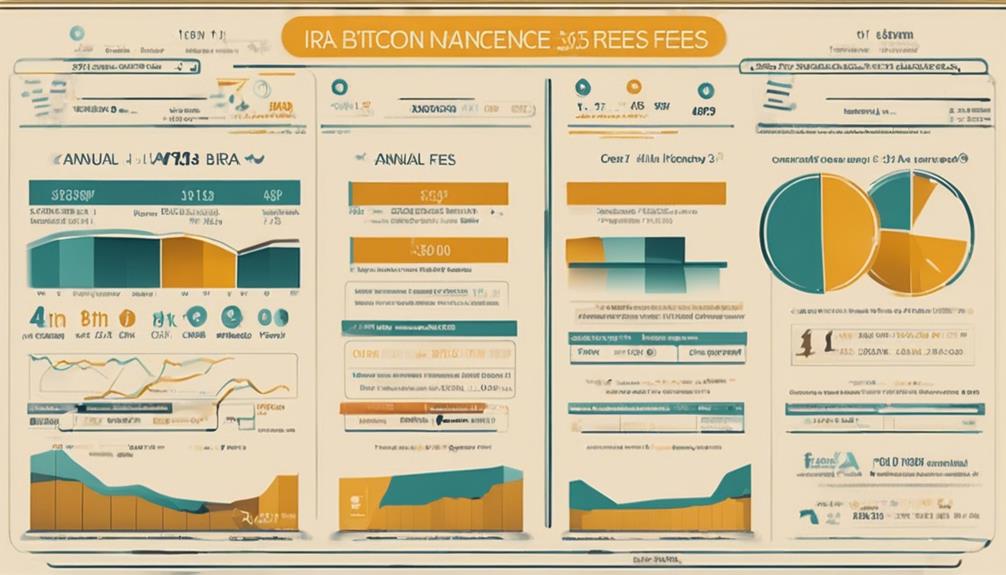When it comes to overseeing retirement accounts, it is crucial to have a good understanding of IRS regulations. It is important to be knowledgeable about different types of accounts such as defined benefit and defined contribution plans. Make sure you are familiar with COVID-19 relief measures that affect required minimum distributions and early withdrawal penalties. Stay informed about recent IRS changes such as contribution limit adjustments to ensure that your financial planning is compliant with current laws. Pay close attention to RMD rules, IRA options, and contribution limits for effective management. Having knowledge about rollovers, beneficiaries, and common plan requirements will improve your retirement strategy. This fundamental knowledge lays the groundwork for a solid financial plan.
Key Takeaways
- Understand contribution limits for tax benefits.
- Comply with RMD rules to avoid penalties.
- Stay informed about IRS updates for adjustments.
- Utilize rollovers for efficient fund transfers.
- Maximize benefits by choosing the right IRA.
Retirement Account Types
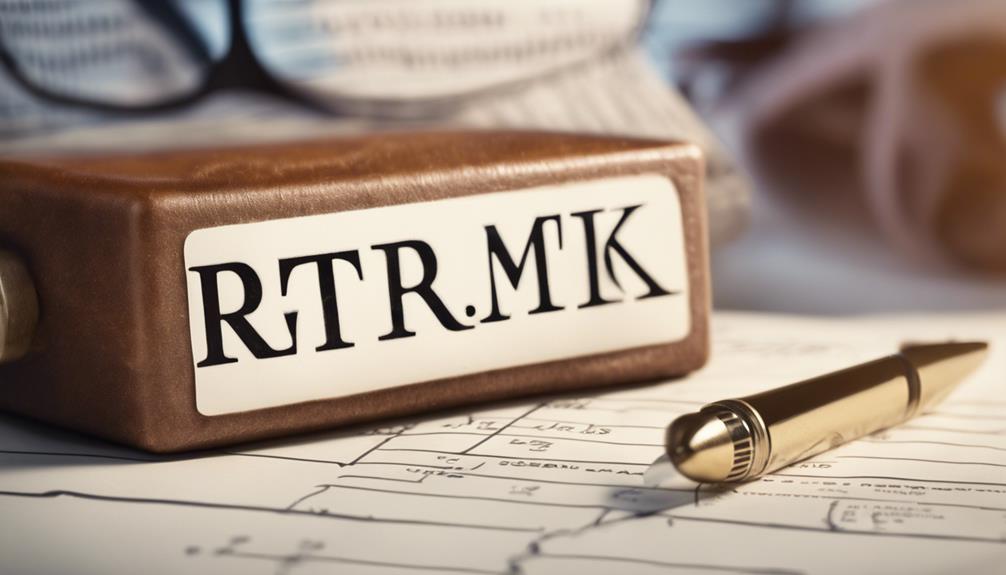
When it comes to retirement account types, we've options like Defined Benefit Plans and Defined Contribution Plans, each offering distinct benefits and structures. Defined Benefit Plans, often referred to as pension plans, provide a fixed, pre-established benefit based on factors such as salary history and years of service. On the other hand, Defined Contribution Plans, such as 401(k) and IRAs, allow individuals to contribute a certain amount to their account, with the eventual benefit determined by contributions and investment returns.
Pension plans guarantee a specific payout upon retirement, offering a sense of security for individuals. In contrast, defined contribution plans give individuals more control over their retirement savings, as the final amount is influenced by how much they contribute and how well their investments perform.
Understanding the differences between these two types of retirement accounts is essential for planning a secure financial future. By choosing the right plan based on individual needs and preferences, one can effectively save for retirement while maximizing benefits.
COVID-19 Relief Measures

Exploring the various retirement account types sheds light on the benefits and structures available, and amidst the COVID-19 pandemic, understanding the relief measures introduced becomes paramount. The IRS has implemented several key provisions to offer relief during these challenging times:
- Required minimum distributions for retirement accounts are waived in 2020 due to COVID-19, providing flexibility for individuals.
- Distributions related to the coronavirus are exempt from the 10% early distribution tax penalty, easing financial burdens.
- COVID-19 relief allows distributions to be included in income over a 3-year period, spreading out the tax impact.
- Individuals have the option to repay COVID-19 related distributions over a 3-year period, helping to replenish retirement savings.
These measures aim to provide financial support and flexibility to individuals managing their retirement accounts during the COVID-19 crisis. Stay informed to make the best decisions for your financial future.
Recent IRS Updates

We have reviewed the recent IRS updates, including an increase in the dollar limit for 401(k) contributions to $23,000 for 2024. The IRS issued technical guidance on cost-of-living adjustments, affecting retirement benefits and contribution limitations. These changes reflect the ongoing commitment to making sure that retirement plans align with economic realities. To help you grasp the impact of these updates, we've prepared the following table:
| Updates | Impact | Importance |
|---|---|---|
| 401(k) Contribution Limit | Increased to $23,000 for 2024 | Maximize retirement savings |
| Cost-of-Living Adjustments | Ensure benefits keep pace with inflation | Protect purchasing power |
| Guidance Changes | Reflect current laws and procedures | Stay compliant with regulations |
Staying informed about these updates is essential for effectively managing your retirement accounts. By subscribing to IRS updates, you can stay ahead of changes and make informed decisions to secure your financial future.
Required Minimum Distributions (RMDs)
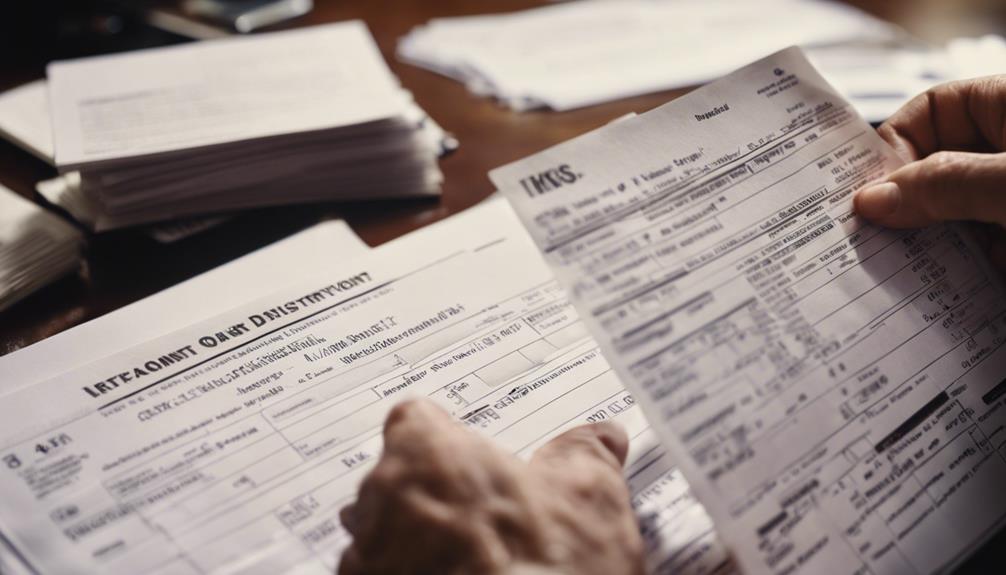
Understanding Required Minimum Distributions (RMDs) is vital for effectively managing retirement accounts and avoiding penalties. When it comes to RMDs, here are four key points to keep in mind:
- Mandatory Withdrawals: RMDs are compulsory withdrawals from retirement accounts that must commence at age 72 to guarantee proper distribution of funds.
- Calculation Basis: The amount you must withdraw as RMD is determined by your account balance and life expectancy, as calculated by IRS guidelines.
- Penalties for Non-compliance: Failure to take the required minimum distributions can lead to significant penalties, potentially reaching up to 50% of the amount that should have been withdrawn.
- Applicability to Account Types: RMD rules are applicable to various retirement accounts, including Traditional IRAs, SEP IRAs, SIMPLE IRAs, 401(k) plans, and other similar accounts. It's essential to understand and adhere to these rules to avoid penalties and ensure proper management of your retirement savings.
Individual Retirement Accounts (IRAs)
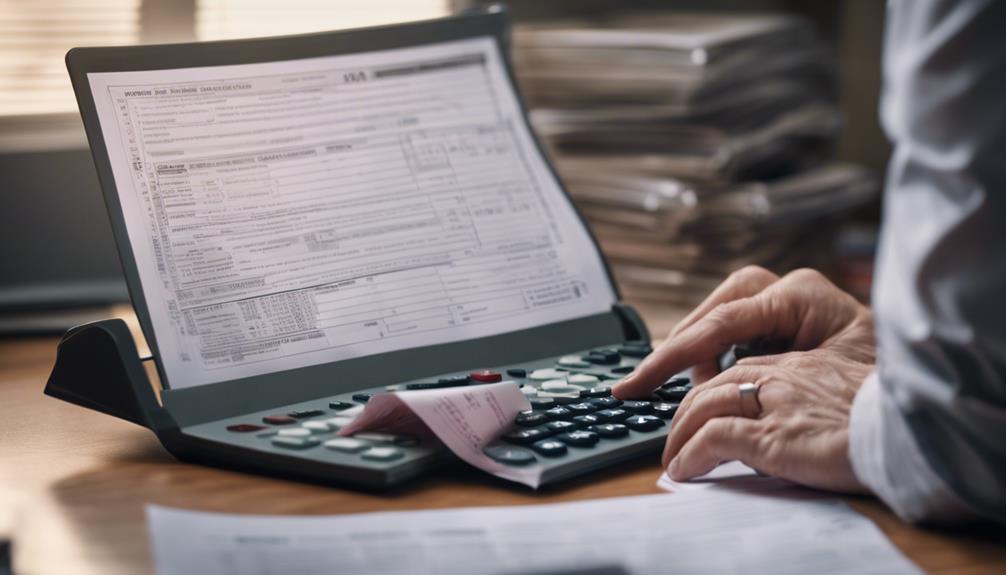
Individual Retirement Accounts (IRAs) provide individuals with tax-advantaged options for saving for retirement, each offering unique benefits and considerations. Traditional IRAs allow for tax-deductible contributions, reducing taxable income in the contribution year and potentially resulting in tax-deferred growth until withdrawal during retirement. On the other hand, Roth IRAs offer tax-free qualified distributions upon retirement, meaning withdrawals aren't subject to federal income tax. When considering which IRA to choose, it's important to weigh factors like current tax situation, expected future tax bracket, and retirement goals.
Both Traditional IRAs and Roth IRAs provide valuable tools for retirement planning, but they differ significantly in how they handle taxation. Understanding these distinctions is crucial for maximizing your retirement savings. Whether you opt for the immediate tax benefits of a Traditional IRA or the tax-free withdrawals of a Roth IRA, these accounts can play an important role in securing your financial future.
Contribution and Deduction Limits
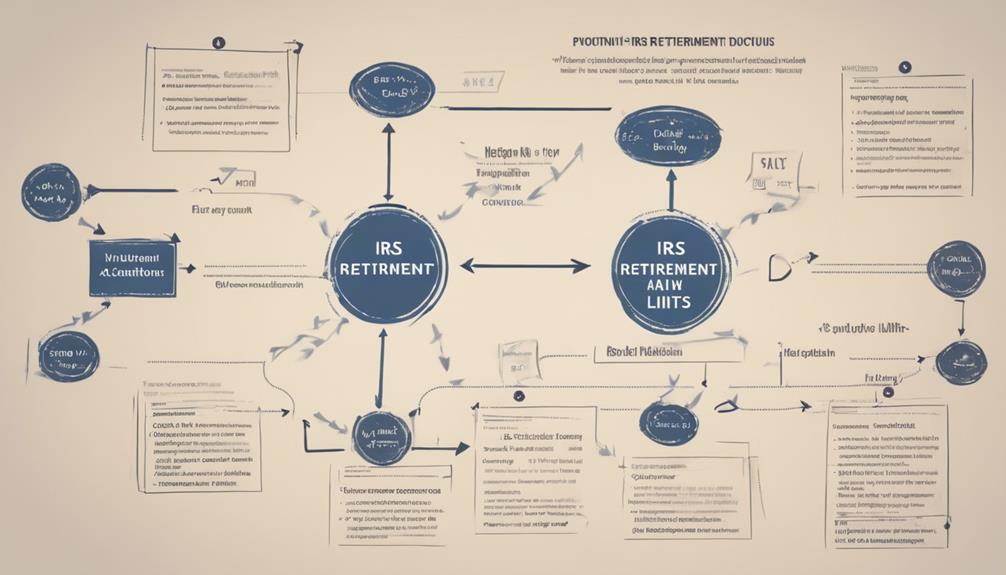
When it comes to your retirement accounts, understanding contribution and deduction limits is essential.
We need to grasp the contribution maximums, strategic tax deduction methods, and the regular updates on annual limits.
Contribution Maximums Explained
In 2023, the contribution maximums for retirement accounts play an important role in determining the extent of tax benefits and savings individuals can achieve within IRS regulations. To navigate these limits effectively, one must understand the following facts:
- The elective deferral limit for a 401(k) plan stands at $22,500, with an additional catch-up contribution of $7,500 for participants aged 50 and over.
- Defined benefit plans have an annual benefit limitation of $265,000.
- Defined contribution plans face an annual contribution limitation of $66,000 in 2023.
- The maximum annual compensation limit for defined contribution plans in 2023 is $330,000, subject to cost-of-living adjustments.
These details are important for individuals seeking to optimize their retirement savings and tax advantages while complying with IRS regulations.
Tax Deduction Strategies
Understanding the IRS regulations for retirement accounts involves strategic planning around tax deduction strategies, particularly focusing on contribution and deduction limits set for different types of retirement plans in 2023. To optimize tax benefits, it's important to stay within the specified limits. Here is a breakdown of the key contribution and deduction limits for 2023:
| Retirement Plan Type | Contribution/Deduction Limit |
|---|---|
| 401(k) elective deferrals | $22,500 (+ $7,500 catch-up for 50+) |
| Defined benefit plans | $265,000 |
| Defined contribution plans | $66,000 |
| Maximum annual compensation | $330,000 |
| Compliance Regulations | Code section 402(g), 415 limits |
Adhering to these limits ensures compliance with IRS regulations and maximizes tax benefits for your retirement savings strategy.
Annual Limit Updates
Understanding the current landscape of retirement account regulations involves staying informed about the annual updates to contribution and deduction limits for various types of retirement plans. Here are some key points to keep in mind: Keeping track of these changes is crucial for optimizing your retirement strategy and ensuring you are taking full advantage of tax-saving opportunities. Familiarity with essential retirement savings regulations can help you make informed decisions about IRA contributions, 401(k) limits, and employer match programs. Staying proactive with these updates not only maximizes your long-term savings but also helps you remain compliant with evolving financial rules.
- The 2023 annual elective deferral limit for 401(k) plans is $22,500, with an additional catch-up contribution of $7,500 for participants aged 50 and over.
- Defined benefit plans have an annual benefit limitation of $265,000 for 2023, while defined contribution plans have a contribution limit of $66,000.
- The maximum annual compensation limit for retirement plans in 2023 is $330,000, subject to cost-of-living adjustments.
- Contribution and deduction limits are set by specific Code sections like 402(g) and 415, ensuring compliance with IRS regulations.
Rollovers and Distributions
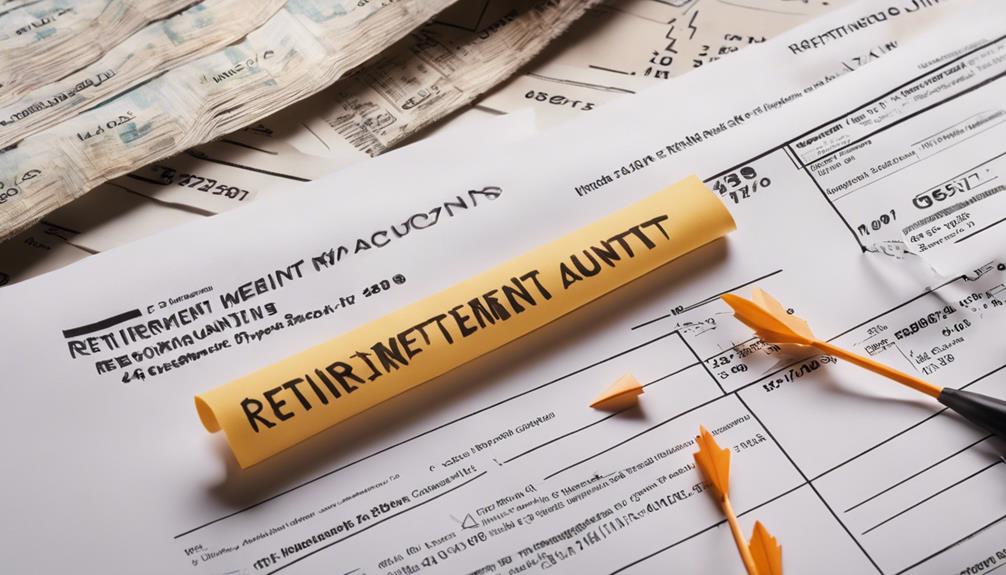
Exploring the terrain of retirement accounts involves smoothly transferring funds through rollovers and understanding distribution requirements. Rollovers offer a tax-efficient way to move retirement savings between accounts, with direct rollovers being the preferred method to avoid tax penalties.
Direct rollovers facilitate the seamless transfer of funds from one retirement account directly to another. It's crucial to be mindful of the required minimum distribution (RMD) age, currently set at 72 years old. RMDs ensure that individuals start withdrawing a minimum amount from their retirement accounts to prevent penalties.
Early distributions before age 59 ½ may incur a 10% early withdrawal penalty unless an exception applies. By adhering to RMD rules and considering the implications of different distribution options, individuals can navigate the complexities of retirement account management effectively.
Understanding the nuances of rollovers and distributions is fundamental to optimizing retirement savings and avoiding unnecessary tax liabilities.
Beneficiaries and Savers Credit

As we navigate through the complexities of retirement account management, it's important to address the considerations surrounding beneficiaries and the potential benefits of the Saver's Credit. When it comes to IRA beneficiaries, understanding the rules can make a significant impact on your long-term financial planning. Here are some key points to ponder:
- Spousal Options: Spouses inheriting an IRA have unique choices for managing distributions and tax implications, providing flexibility in their approach.
- Non-Spousal Rules: Non-spousal beneficiaries of an IRA must adhere to specific guidelines concerning withdrawals and tax treatment, ensuring compliance with regulations.
- Saver's Credit: Eligible contributions to an IRA can qualify for the Saver's Credit, offering potential tax savings of up to $1,000, which can enhance your retirement savings strategy.
- Maximizing Benefits: Understanding beneficiary rules for IRAs is essential for optimizing benefits and minimizing tax consequences, emphasizing the importance of thorough planning.
Common Qualified Plan Requirements

When it comes to common qualified plan requirements, we need to take into account:
- Plan eligibility criteria
- Contribution limits overview
- Vesting schedule basics
These elements are essential for maintaining a retirement account's tax-qualified status and ensuring compliance with IRS regulations. Understanding these points will help individuals navigate the complexities of qualified plans effectively.
Plan Eligibility Criteria
To meet common qualified plan requirements, employers typically need to make sure that employees are at least 21 years old and have completed at least one year of service with the company. When determining plan eligibility criteria, it's essential to take into account various factors, including:
- Minimum Hours Worked: Qualified plans usually cover employees who've worked at least 1,000 hours in a year.
- Exclusions: Certain groups, such as nonresident aliens and union employees under a collective bargaining agreement, may be excluded from the plan.
- Nondiscrimination Testing: Employers must conduct nondiscrimination testing to make sure that benefits are fairly distributed among all employees, including highly compensated individuals.
- Adherence to IRS Guidelines: Qualified plans must comply with specific contribution limits and vesting schedules set forth by the IRS.
Contribution Limits Overview
Exploring the Contribution Limits Overview in common qualified retirement plans, we encounter specific guidelines set forth by the IRS that dictate the maximum amounts individuals can contribute annually.
For 401(k) plans, the contribution limits are determined by Code section 402(g, with a cap of $22,500 in 2023. Individuals aged 50 and over have the option to make additional elective deferrals up to $7,500 in 2023.
In defined benefit plans, the annual benefit limitation was $265,000, while in defined contribution plans, the annual contribution limit stood at $66,000 for 2023.
Additionally, the maximum annual compensation limit for 2023, as per Code section 415, was $330,000.
It's important for individuals to stay informed about these limits and any plan amendments to make the most of eligible rollovers.
Vesting Schedule Basics
Understanding vesting schedules in common qualified retirement plans is essential for individuals to secure their financial future effectively. When it comes to vesting schedules in 401(k) plans, there are key points to keep in mind:
- Vesting schedules determine when employees gain full ownership of employer-contributed retirement plan funds.
- Common types of vesting schedules include cliff vesting and graded vesting.
- The maximum vesting period allowed by law for most plans is six years, with variations for different vesting types.
- Vesting schedules can differ among various retirement plans like 401(k) plans, defined benefit plans, and employee stock ownership plans. Understanding these intricacies is crucial for maximizing retirement benefits.
Frequently Asked Questions
What Are the Guidelines for Retirement Funds?
Retirement fund guidelines set by the IRS cover contributions, distributions, RMDs, and more. Specific rules on limits, deductibility, investments, and eligibility are essential. Compliance avoids penalties, maximizes tax benefits, and secures retirement.
Staying informed about IRS updates is key for smart financial decisions.
Do Retirement Accounts Need to Be Reported to the Irs?
Retirement accounts aren't required to be reported to the IRS upon setup. However, contributions made are typically reported in the year they're deposited.
Withdrawals or distributions may need reporting, especially if taxable. Transactions like rollovers may have IRS reporting requirements.
It's important to maintain accurate records of contributions, withdrawals, and tax-related transactions for IRS reporting. Keeping track guarantees compliance with regulations and financial transparency.
What Is the New Tax Law on Retirement Accounts?
The new tax law on retirement accounts includes several key provisions to provide relief and flexibility during the COVID-19 pandemic.
One significant change is the waiver of required minimum distributions for the year 2020. This alleviates the pressure on retirees who may not want to sell investments in a down market to meet these requirements.
Another important provision is the exemption of COVID-19-related distributions from the 10% early distribution tax. This allows individuals facing financial hardship due to the pandemic to access their retirement funds without penalty.
Furthermore, individuals who take distributions this year have the option to include the income over three years for added flexibility. They also have the opportunity to repay the distribution over the same period, helping to mitigate the long-term impact on their retirement savings.
In addition, the law extends plan loan limits and repayment periods, providing more leeway for individuals to borrow from their retirement savings if needed.
Collectively, these changes offer relief and increased options for managing retirement accounts during these challenging times, ensuring that individuals have the flexibility and support they need to navigate the financial impact of the pandemic.
How Does an IRA Work for Dummies?
IRA works by providing tax advantages for retirement savings. Traditional IRAs allow tax-deductible contributions, while Roth IRAs offer tax-free growth.
Contributions are subject to annual limits set by the IRS. Understanding IRA basics involves knowing about contributions, investments, distributions, and tax implications.
It's an essential tool for retirement planning, offering flexibility and potential long-term growth. Mastering IRA workings can help secure a stable financial future.
Conclusion
To sum up, understanding IRS regulations for retirement accounts can seem challenging, but with a bit of knowledge and guidance, it can be manageable.
Grasping the different account types, recent updates, contribution limits, and distribution rules is key to making informed decisions for your retirement savings.
By staying informed and following the regulations, you can guarantee a smooth and successful retirement planning journey. Remember, knowledge is power when it comes to securing your financial future.






